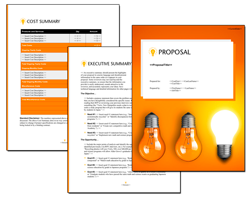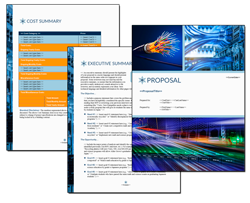
AI RFP Analysis: The Future of Competitive Proposal Management
The business world is experiencing a seismic shift as artificial intelligence transforms every aspect of how organizations discover, analyze, and respond to Requests for Proposals. What once required days of manual effort and coordination among proposal teams can now be accomplished in minutes with AI-powered tools that understand complex requirements, generate tailored responses, and optimize content for AI reviewers.
Companies that embrace this AI revolution aren't just working smarter; they're fundamentally changing the competitive landscape. While traditional proposal professionals struggle with repetitive tasks and manual processes, AI-enabled teams are securing more business by leveraging response intelligence, proposal automation, and sophisticated analysis capabilities that deliver winning proposals at unprecedented speed and scale.
The future belongs to organizations that master both sides of the AI equation: creating RFPs that pass artificial intelligence reviewers and responding with optimized, AI-vetted proposals that rank on top. This transformation is already happening across government tenders, commercial contracts, and security questionnaires, making AI proficiency not just an advantage but a necessity for survival in our increasingly complex world.
The AI Revolution in RFP Management
The traditional RFP process has been plagued by inefficiencies that drain resources and limit scalability. Proposal teams spend countless hours extracting requirements from rfp documents, coordinating with subject matter experts, and manually tracking deadlines across multiple rfp formats. This legacy approach creates bottlenecks that prevent organizations from pursuing more deals and achieving optimal win rates.
AI is dismantling these barriers by introducing intelligent automation throughout the entire proposal process. Modern AI capabilities now handle everything from initial opportunity discovery to final proposal scoring, creating collaborative workflows that seamlessly integrate human expertise with machine efficiency. The result is a dramatic reduction in response time while simultaneously improving proposal quality and compliance.
Early adopters are already seeing transformational results. Organizations implementing AI-powered RFP management report 80-90% reductions in manual effort, with AI handling the heavy lifting of content generation, requirement analysis, and initial draft creation. These teams maintain full control over strategic positioning while letting AI agents manage repetitive tasks and data processing.
The winners in this new landscape will be companies that recognize AI's potential across the entire RFP ecosystem. Success requires understanding how to leverage AI for opportunity discovery, requirement analysis, proposal writing, and optimization for AI reviewers. Organizations that master these capabilities will dominate their markets while competitors struggle with outdated manual processes.
Using AI to Research and Discover RFP Opportunities

The first advantage of AI RFP analysis begins before you even see a formal solicitation. AI-powered platforms are revolutionizing how businesses discover relevant opportunities by continuously scanning government databases like SAM.gov, state procurement portals, and commercial RFP repositories. These systems use natural language processing to match opportunities against company profiles, capabilities, and strategic objectives.
Machine learning algorithms analyze historical bidding patterns, success rates, and competitive landscapes to provide intelligent scoring of each opportunity. Rather than relying on manual searches or keyword alerts, AI evaluates the full context of requirements, evaluation criteria, and market dynamics to recommend opportunities with the highest probability of success.
Advanced platforms integrate with business intelligence tools to provide comprehensive market analysis, identifying emerging trends in specific sectors and predicting when agencies or corporations are likely to issue new RFP questionnaires. This forward-looking capability allows organizations to prepare winning strategies before opportunities are formally announced.
Real-world implementations demonstrate the power of this approach. Federal contractors using AI discovery platforms report finding more relevant opportunities while reducing research time by 75%. These systems provide automated alerts with detailed analysis, helping proposal professionals focus their energy on the most promising pursuits rather than endless opportunity screening.
The integration capabilities extend beyond simple discovery. AI platforms connect with CRM systems, project management tools, and knowledge bases to provide holistic opportunity assessment. Teams can instantly access past proposals, customer data, and relevant content libraries to make informed bid/no-bid decisions with unprecedented speed and accuracy.
The Rise of AI-Generated RFPs
While organizations focus on improving their response capabilities, procurement teams are simultaneously leveraging AI to create better, more standardized RFPs. Government agencies and corporations are using generative AI tools like ChatGPT, Claude, and specialized government applications to draft comprehensive solicitations with improved clarity and consistency.
AI-generated RFPs demonstrate superior structure and completeness compared to manually created documents. These tools ensure all critical evaluation criteria are included, deadlines are realistic, and requirements are clearly articulated. The result is a more efficient procurement process that reduces questions from vendors and produces higher-quality RFP responses.
Standardization improvements are particularly evident in evaluation matrices and scoring criteria. AI helps procurement teams create objective, measurable criteria that reduce bias and improve fairness. These AI-created frameworks also optimize for automated evaluation, making it easier for AI models to assess and rank proposals consistently.
The impact on traditional RFP writing is already visible across federal and commercial sectors. Agencies report significantly faster RFP development cycles while maintaining higher quality standards. This acceleration means more opportunities reaching the market, creating increased competition, but also more chances for prepared organizations to win new business.
Examples of AI-created RFPs are appearing particularly in technology, professional services, and construction contracts. These documents feature enhanced technical specifications, clearer evaluation criteria, and better alignment with automated assessment tools that agencies increasingly use for initial proposal screening.
AI RFP Analysis Tools: Understanding Requirements Instantly
At the heart of modern proposal management lies sophisticated AI RFP analysis technology that transforms how teams understand and respond to complex solicitations. Tools like Proposal Kit's AI RFP Analyzer represent a new generation of RFP software that automatically extracts requirements, identifies compliance obligations, and maps opportunities against organizational capabilities.
These systems process RFP documents in multiple file types, from traditional Word documents to complex PDF submissions and spreadsheet-based questionnaires. Natural language processing algorithms parse every section, creating structured requirement matrices that highlight mandatory elements, evaluation criteria, and submission deadlines. This automated analysis eliminates the manual effort traditionally required for requirement extraction.
Compliance matrix generation happens automatically, with AI identifying potential risk areas and gaps in organizational capabilities. The system cross-references requirements against approved content libraries, past proposals, and company documentation to flag areas needing attention. This proactive approach prevents compliance failures that could disqualify otherwise competitive proposals.
Deadline tracking and resource planning recommendations provide project management capabilities that ensure teams meet all submission requirements. AI analyzes the complexity of requirements, estimates effort levels, and suggests optimal resource allocation based on historical data and organizational capacity. This intelligence helps teams make realistic commitments while maximizing their chances of success.
Integration with existing proposal management systems ensures seamless workflows that don't disrupt established processes. Modern AI tools connect with Microsoft Teams, Google Drive, and other collaboration platforms to enable real-time collaboration while maintaining version control and audit trails throughout the proposal development process.
How AI Analyzes Company Capabilities

Advanced AI RFP analysis goes beyond simple requirement extraction to provide strategic intelligence about organizational fit and competitive positioning. AI systems learn company products, services, past performance, and core competencies to automatically assess capability gaps against specific RFP requirements. This analysis helps teams make informed bid/no-bid decisions based on objective assessments rather than subjective opinions.
Automated capability gap analysis identifies areas where organizations may need to develop new competencies, form partnerships, or clearly articulate existing but under-documented capabilities. The AI considers not just current requirements but also emerging trends and future opportunities, helping businesses invest in areas that will drive long-term growth.
Strategic bid/no-bid recommendations combine historical win rates, competitive intelligence, and resource availability to provide data-driven guidance on opportunity pursuit. These systems consider factors like customer relationships, past performance with similar requirements, and current pipeline capacity to recommend optimal bidding strategies.
Resource allocation suggestions help teams optimize their proposal development efforts by identifying which opportunities deserve maximum investment and which can be addressed with lighter touch approaches. This intelligence enables organizations to pursue more opportunities while maintaining quality standards across all responses.
Building AI-Powered Proposal First Drafts
The most dramatic transformation in proposal writing comes from AI tools that generate comprehensive first drafts in minutes rather than days. Solutions like Proposal Kit's AI Writer leverage company knowledge bases, past proposals, and requirement analysis to create first-draft proposals that require only strategic refinement and technical review.
Template-based proposal generation ensures consistency and completeness while adapting content to specific RFP requirements. AI understands the relationship between different proposal sections, automatically generating executive summaries that align with technical approaches and pricing strategies. This holistic approach produces coherent documents that read naturally despite being machine-generated.
Automated content library integration represents a breakthrough in proposal efficiency. AI systems search through years of approved content, identifying the most relevant information for each requirement and adapting language and examples to fit the current opportunity. This intelligent reuse prevents teams from starting from scratch while ensuring each response feels fresh and targeted.
Technical writing assistance helps teams address complex requirements with precision and clarity. AI can translate technical specifications into business benefits, explain complicated processes in an accessible language, and ensure consistency in terminology and formatting throughout lengthy documents. This capability is particularly valuable for teams responding to government tenders with strict formatting and content requirements.
Speed improvements are revolutionary. What traditionally required weeks of coordination among proposal teams now happens in hours, with AI handling initial content generation while humans focus on strategic positioning and competitive differentiation. Teams report completing more proposals with higher quality while reducing stress and deadline pressure.
Content Quality and Customization
AI-generated content maintains a consistent voice and messaging across all proposal sections, eliminating the disjointed feel that often results from multiple authors working on different sections. The technology learns organizational writing styles, key messaging themes, and approved terminology to produce content that sounds authentically human while meeting all technical requirements.
Customization based on client preferences and past winning proposals enables truly tailored responses that demonstrate understanding of customer priorities and preferences. AI analyzes successful proposals to identify winning themes, persuasive arguments, and effective presentation strategies, then adapts these approaches to new opportunities.
Integration with CRM data provides personalized responses that reference specific customer relationships, past performance history, and documented preferences. This level of customization was previously impossible at scale, but now becomes standard practice for AI-enabled teams seeking competitive advantage.
Compliance checking during content generation prevents costly errors by continuously validating content against RFP requirements, formatting guidelines, and regulatory obligations. The AI flags potential issues in real-time, ensuring that generated content meets all submission criteria before human review begins.
Human-in-the-Loop: The Essential Review Process
Despite AI's impressive capabilities, human expertise remains critical for ensuring proposal quality, strategic positioning, and competitive differentiation. The most successful teams implement structured review workflows that combine AI efficiency with human judgment, creating a collaborative process that leverages the strengths of both artificial intelligence and human intelligence.
Subject matter experts provide essential validation of technical accuracy and feasibility. While AI excels at content generation and requirement analysis, humans bring deep domain knowledge, practical experience, and strategic insight that ensure proposals are not only compliant but also compelling and credible. This human oversight prevents AI from making promises the organization cannot deliver.
Strategic positioning and competitive differentiation require human insight that understands market dynamics, customer relationships, and competitive threats. Proposal professionals use AI-generated drafts as a foundation for creating persuasive narratives that highlight unique value propositions and competitive advantages. This strategic layer transforms compliant responses into winning proposals.
Final AI double-checking provides an additional quality assurance layer that catches errors, inconsistencies, and compliance issues that might escape human review. AI tools can quickly scan entire proposals for formatting errors, missing requirements, and logical inconsistencies, providing a safety net that ensures submission quality. This dual review process significantly reduces proposal risks while maintaining efficiency gains.
Quality control checkpoints throughout the proposal process ensure that AI-generated content meets organizational standards and customer expectations. Teams establish review criteria that balance speed with quality, using AI to handle routine checks while reserving human attention for strategic and technical validation.
Best Practices for AI-Human Collaboration

Optimal division of tasks between AI and human reviewers maximizes efficiency while ensuring quality outcomes. AI handles initial content generation, requirement extraction, compliance checking, and formatting, while humans focus on strategic messaging, technical validation, competitive positioning, and customer relationship considerations. This division leverages each party's strengths while minimizing weaknesses.
Training teams to work effectively with AI writing tools requires new skills and workflows that differ significantly from traditional proposal development. Successful organizations invest in training that helps team members understand AI capabilities and limitations, learn prompt engineering techniques, and develop quality review processes optimized for AI-generated content.
Version control and collaboration in hybrid workflows prevent confusion and ensure all team members can contribute effectively to proposal development. Modern proposal management platforms integrate AI capabilities with collaborative workflows, enabling multiple reviewers to work simultaneously while maintaining clear audit trails and change tracking.
The most effective teams develop standard operating procedures that define roles, responsibilities, and handoff points between AI and human contributors. These procedures ensure consistent quality while enabling teams to scale their proposal capacity without proportional increases in staffing or resources.
AI-Powered Proposal Evaluation by RFP Providers
The other side of the AI revolution involves how government agencies and corporations evaluate incoming proposals. Automated compliance checking and initial screening processes now handle first-level evaluations, with AI systems rapidly identifying submissions that fail to meet basic requirements or formatting guidelines. This automation enables procurement teams to focus their attention on substantive evaluation rather than administrative compliance checking.
Natural language processing for technical evaluation represents a significant advancement in proposal assessment. AI systems can analyze technical approaches, identify innovation elements, and assess feasibility based on industry knowledge and best practices. These capabilities enable more consistent and objective evaluation while reducing the time required for initial technical review.
Bias reduction and standardized evaluation criteria improve fairness and transparency in the procurement process. AI evaluation reduces subjective interpretation and ensures all proposals are assessed against identical criteria with consistent weighting. This standardization benefits both evaluators and vendors by creating more predictable and equitable processes.
Real examples from GSA and major corporations demonstrate the growing adoption of AI evaluation. Federal agencies report faster evaluation cycles with improved consistency and reduced protest rates. Commercial organizations cite similar benefits, particularly for high-volume procurement processes like security questionnaires and professional services contracts.
The implications for proposal strategy are significant. Understanding how AI systems evaluate proposals becomes essential for optimizing submission strategies and maximizing scoring potential. Organizations that master AI optimization techniques gain substantial advantages over competitors using traditional proposal approaches.
Optimizing Proposals for AI Reviewers
Understanding how AI systems evaluate proposals requires knowledge of natural language processing algorithms, scoring methodologies, and evaluation criteria weighting. AI reviewers focus on different elements than human evaluators, emphasizing compliance, clarity, and quantifiable benefits over narrative persuasion and relationship-building content.
Keyword optimization and semantic relevance strategies help proposals score higher with AI evaluation systems. However, this optimization must be subtle and natural, avoiding keyword stuffing or artificial language that could trigger negative scoring algorithms. The best approach balances AI optimization with human readability and persuasiveness.
Structured formatting for AI parsing and analysis ensures that key information is easily identified and properly categorized by automated systems. This includes consistent use of headers, bullet points, tables, and other formatting elements that help AI understand document structure and extract relevant information for scoring purposes.
Avoiding common AI evaluation pitfalls requires understanding what triggers negative responses from automated systems. Inconsistent terminology, missing required information, poor formatting, and vague or unsupported claims can significantly reduce AI scoring even when human evaluators might overlook these issues.
Ensuring Your Proposals Pass AI Screening
The critical importance of AI-optimized proposal strategies cannot be overstated in today's competitive environment. Organizations must adapt their proposal development processes to succeed with both AI and human evaluators, recognizing that AI screening often determines which proposals advance to human review. Failure to optimize for AI evaluation can eliminate even the most compelling proposals before they receive serious consideration.
Technical requirements for AI-readable proposal formats include consistent structure, clear headers, appropriate use of tables and lists, and strategic placement of key information. Modern rfp software helps teams format proposals correctly while maintaining visual appeal for human readers. These technical considerations become increasingly important as more organizations adopt automated screening processes.
Testing proposals against AI evaluation criteria provides valuable feedback before submission. Some organizations use AI simulation tools to predict how their proposals will score with automated systems, enabling last-minute optimizations that improve competitive positioning. This testing capability becomes a standard practice for serious competitors.
Continuous improvement based on AI feedback loops helps organizations refine their proposal strategies over time. By analyzing which proposals succeed with AI evaluation and which fail, teams can identify patterns and adjust their approaches accordingly. This data-driven improvement process accelerates learning and improves win rates.
Case studies of companies winning more with AI-optimized approaches demonstrate the real-world benefits of these strategies. Organizations report dramatic improvement in win rates after implementing AI optimization techniques, with particularly strong results in government contracting and large commercial opportunities where AI screening is most common.
The Competitive Advantage of AI Adoption
Speed to market advantages for AI-enabled proposal teams create significant competitive moats that become more pronounced over time. While competitors struggle with traditional proposal development timelines, AI-powered teams can respond to more opportunities with higher-quality submissions. This velocity advantage compounds over multiple sales cycles, enabling market share growth and revenue acceleration.
Cost reduction and resource optimization benefits enable organizations to pursue opportunities that were previously economically unfeasible. By reducing the human resources required for proposal development, AI makes it practical to respond to smaller contracts and longer-shot opportunities that could provide strategic value or market entry advantages.
Improved win rates through better analysis and targeting represent the ultimate measure of AI success in proposal management. Organizations using a comprehensive AI RFP analysis report consistently higher success rates because they make better bid/no-bid decisions, develop more compelling responses, and optimize for both human and AI evaluation criteria.
Scalability for handling larger volumes of opportunities transforms business development capacity without proportional increases in staffing. AI-enabled teams can evaluate more opportunities, develop more proposals, and maintain higher quality standards across their entire portfolio of pursuits. This scalability becomes particularly valuable in markets with high opportunity volumes or seasonal bidding cycles.
Future-proofing against AI-native competitors ensures long-term viability in markets where AI adoption accelerates. Early adopters gain experience and optimize their processes while competitors lag behind. As AI becomes standard practice, organizations without these capabilities will find themselves at insurmountable disadvantages in competitive situations.
Implementation Roadmap: Getting Started with AI RFP Analysis
Assessing current proposal processes and AI readiness requires an honest evaluation of existing capabilities, pain points, and resource constraints. Organizations should audit their current workflows, identify bottlenecks and inefficiencies, and determine which AI capabilities would provide the greatest immediate value. This assessment guides investment priorities and implementation sequencing.
Selecting appropriate AI tools for different organization sizes requires careful consideration of features, costs, integration requirements, and scalability. Small teams might prioritize simple AI writing assistants, while large organizations need comprehensive proposal management platforms with advanced analytics and workflow automation. The key is choosing solutions that grow with the organization's needs.
Training and change management considerations are critical for successful AI adoption. Teams must learn new skills, adapt existing workflows, and overcome resistance to AI-assisted processes. Successful implementations include comprehensive training programs, clear success metrics, and phased rollouts that allow teams to build confidence gradually.
Pilot program recommendations focus on specific use cases where AI can demonstrate clear value quickly. Many organizations start with AI-powered content generation for standard proposal sections, then expand to requirement analysis and opportunity discovery as teams gain experience and confidence with the technology.
Timeline for full AI integration in proposal operations typically spans a year or more, depending on organizational size and complexity. Successful implementations balance speed with thoroughness, ensuring that each phase builds capabilities that support subsequent expansions. The goal is sustainable adoption that improves outcomes while maintaining team morale and engagement.
Key AI Tools to Consider

Proposal Kit AI RFP Analyzer and AI Writer represent comprehensive solutions that address multiple aspects of proposal development for small businesses. These tools provide integrated workflows that handle everything from requirement analysis to final draft generation, with features designed specifically for proposal professionals and established integration capabilities with common business systems.
Alternative platforms offer specialized strengths for different types of organizations and use cases. Some focus on government contracting with a deep understanding of federal procurement requirements, while others optimize for commercial opportunities or specific industries like healthcare or technology services. The key is matching platform capabilities with organizational needs and priorities.
Integration requirements with existing systems vary significantly based on current technology infrastructure and workflow preferences. Modern AI platforms offer flexible integration options, including APIs, direct integrations with popular business applications, and cloud-based solutions that minimize technical requirements while maximizing capability access.
Security and compliance considerations for different industries require careful evaluation of data handling practices, access controls, and regulatory compliance features. Organizations in healthcare, finance, defense, and other regulated industries need AI solutions that meet specific security standards while providing full audit trails and customer data protection.
The Future is Now: AI RFP Trends Already Emerging
Current adoption rates in federal contracting and commercial sectors indicate rapid acceleration toward AI-powered proposal management. Government data shows increasing use of automated evaluation tools, while commercial organizations report growing investment in AI-powered procurement and vendor management systems. This trend creates both opportunities and challenges for organizations developing their AI strategies.
Early success stories and lessons learned from AI implementations provide valuable insights for organizations beginning their journey. Successful adopters emphasize the importance of gradual implementation, comprehensive training, and maintaining human oversight throughout the process. Common pitfalls include over-reliance on AI without human validation and insufficient attention to AI optimization in proposal strategies.
Predicted timeline for widespread AI adoption in proposal management suggests that AI capabilities will become standard in the coming years. Organizations that begin their AI journey now will have significant advantages over late adopters, particularly in terms of team experience, process optimization, and competitive positioning.
Preparing for the next wave of AI innovations requires staying informed about emerging technologies and maintaining flexible, adaptable systems. Future developments likely include more sophisticated AI agents, improved integration capabilities, and advanced analytics that provide deeper insights into proposal performance and market trends.
The final call to action is clear: companies must start their AI journey today to remain competitive in tomorrow's marketplace. The organizations that master AI RFP analysis, implement comprehensive AI-powered workflows, and optimize their approaches for AI evaluation will dominate their markets while competitors struggle with outdated manual processes.
The transformation is already underway. The question isn't whether AI will revolutionize proposal management; it's whether your organization will lead this revolution or be left behind by competitors who embrace the future. The time to act is now, and the tools to succeed are available today. Your competitive advantage depends on how quickly you can adapt to this new reality and begin leveraging artificial intelligence to win more business in our increasingly complex world.



 Cart
Cart
 If you already know you want the RFP analysis software, get it here. The RFP Analyzer is included in every
If you already know you want the RFP analysis software, get it here. The RFP Analyzer is included in every 

 Facebook
Facebook YouTube
YouTube Bluesky
Bluesky Search Site
Search Site